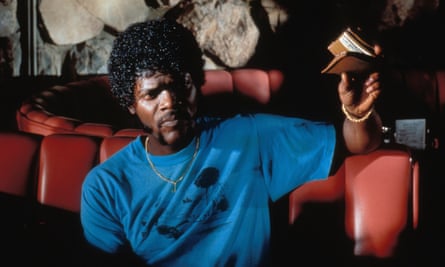Opening Pulp Fiction with the literal two-part definition of “pulp” is a wink and a nudge on writer-director Quentin Tarantino’s part, funny in retrospect when the first definition (“a soft, moist, shapeless mass of matter”) aptly describes the pieces of brain and skull that are accidentally splattered across the back of a 1974 Chevy Nova. Perhaps Tarantino felt some need to offer the audience a formal introduction to the type of low-down genre trash that had always existed outside the mainstream, in lurid dimestore paperbacks or filthy grindhouse theaters. This was not going to be a typical contender for the Palme d’Or at the Cannes film festival, let alone the actual winner.
Yet there’s a swagger to Pulp Fiction that makes you believe Tarantino, a true moviemaking savant, could see the film’s future laid out in front of him – the Palme d’Or, the screenplay Oscar, the crossover into a genuine pop culture phenomenon. The transition from the opening scene, where a couple of outlaws resolve to rob an entire Los Angeles diner at breakfast, to the snarling surf rock of Dick Dale’s rendition of Misirlou over the credits feels like Kurt Cobain playing the riff to Smells Like Teen Spirit. Its electricity is that undeniable and surely Tarantino himself must have known it. The film radiates confidence.
Tarantino is an architect and an alchemist. The same instinct that has led him to curate his career to precisely 10 features before retirement – born perhaps of a fear that he would lose his touch as he aged, like John Carpenter – informs the ingenious, achronological structure of Pulp Fiction, which orders three stories and other scenes into a thematically meaningful whole that’s much greater than the considerable sum of its parts. But it’s in his mixing-and-matching of high and low influences that Tarantino stands apart, suggesting the diet of a VHS hound who could include early Jean-Luc Godard and Jean-Pierre Melville in the same binge as crude exploitation pictures. He has too much love for the latter to act like he’s “elevating” the crime genre, but there’s a sophistication to Pulp Fiction all the same. He was somehow invading arthouses and multiplexes simultaneously.
There was already plenty of evidence in Tarantino’s debut feature, Reservoir Dogs, that he was deft at building conceits around a terrific ensemble, in that case a heist picture without the heist, set mostly in the tense (and cost-effective) steam-cooker of an empty warehouse. With more of a budget – though still astonishingly modest even for the time, at a little over $8m – Tarantino opens Pulp Fiction up into his Los Angeles, which has its own distinct alchemy, combining the Hollywood kitsch of locales like Jackrabbit Slim’s with the downscale LA where actual people live, work, eat Big Kahuna burgers for breakfast, and occasionally distribute small bags of premium heroin. Maybe he’s an anthropologist, too.
The major innovation of Pulp Fiction, the one that its many imitators could almost never get right, is how Tarantino’s witty, discursive dialogue differed from even the stylized language of classic genre films. The gossip, banalities and random asides of everyday conversation – or at least Tarantino’s much livelier version of everyday conversation – surfaces early in the banter between two hitmen, Vincent Vega (John Travolta) and Jules Winnfield (Samuel L Jackson), occupying the dead space between jobs. There’s talk of hash bars and movie theaters in Amsterdam, how the metric system changes a menu item at McDonald’s, and the failed TV pilot starring Mia Wallace (Uma Thurman), wife of their boss Marsellus (Ving Rhames).
There’s a pleasing musicality to the language, as well as a reminder that these movie types have a firm footing in the real world – and may, in talking about the “little differences” of fast food and movie brews in Europe, have a lot in common with Americans who still cling to home while they’re overseas. And when they discuss the finer points of the foot massage that supposedly led Marcellus to toss a Samoan henchman off a four-story balcony, Tarantino also sets the table for the first of three vignettes in which Vincent takes Mia out for a wilder-than-expected night on the town. An underrated aspect of Pulp Fiction, and Tarantino’s work in general, is that his dialogue is purposeful, even when it seems like it’s adrift on a tangent.

Pulp Fiction does not get better than the first hour or so, when the prelude at the diner leads into the introduction of Vincent and Jules on a gruesome assignment, which then segues into “Vincent Vega and Marsellus Wallace’s Wife”, a segment that remains the touchstone of Tarantino’s career. Much of the film’s budget for art direction was spent on the set of Jackrabbit Slim’s, a theme restaurant where an Ed Sullivan impersonator is maitre d’ and the waiter is a disgruntled Buddy Holly (Steve Buscemi). But there’s a special magic to Travolta, whose fortunes in Hollywood had long since hit the skids, reviving his Saturday Night Fever image by doing the twist, and a thrill to the gearshift moment when Thurman’s Mia, a cocaine addict, hoovers up a line of smack.
The two stories that come later, The Gold Watch, about Butch (Bruce Willis), a boxer who needs to collect a family heirloom after double-crossing Marsellus in the ring, and The Bonnie Situation, about the race to clean up the bloody mess in the back of the Nova, are significantly less galvanizing on their own, though each is still speckled with unforgettable moments. Yet their careful placement in the overall film gives this collection of vignettes a cumulative power, as themes of honor and redemption start to surface, along with the god-like mechanisms of karma and fate.
The first and the last scenes in Pulp Fiction are dead center in the timeline, which makes Jules’s life-changing decision in the final moments so affecting, as if time itself has stopped so he can get off board. (The way the timelines converge at that moment is exceptionally elegant and tension-raising.) That a hitman could have this moment of spiritual epiphany is a surprise in itself, but Tarantino’s ability to thread it through a Mexican standoff like the one he staged so memorably in Reservoir Dogs puts it in genre terms. Even when Pulp Fiction reaches for the profound, it’s still got a nasty kick to it.
Source: theguardian.com


